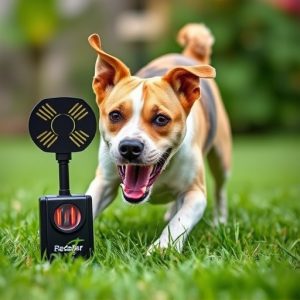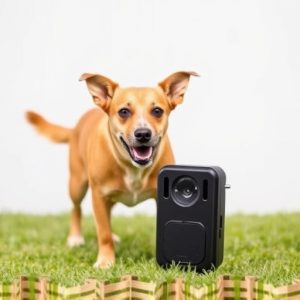Unleash Peace: Ultrasonic Dog Deterrents & Their Effective Distance
Ultrasonic dog deterrents, leveraging high-frequency sound waves (22-52 kHz) that humans can't…….
Ultrasonic dog deterrents, leveraging high-frequency sound waves (22-52 kHz) that humans can't hear, are effective and humane tools for keeping dogs away from specific areas like gardens or entry points. Their range of 50-100 feet and consistent usage reinforce positive behavior changes. For optimal results with an electronic dog deterrent, maintain a 10-15 feet (3-4.5 meters) effective distance, address weather, breed, and distractions, and follow manufacturer guidelines for gradual, consistent usage.
“Unleash a new way to keep your home pest-free with ultrasonic dog deterrents – a revolutionary, non-toxic solution. This article guides you through the science and benefits of these devices, offering insights into their effective distance and frequency range as electronic dog deterrents.
From understanding how they work to practical implementation tips for optimal results, discover why ultrasonic deterrents are a top choice for pet owners. Learn about their advantages and unique considerations in the battle against unwanted four-legged visitors.”
- Understanding Ultrasonic Dog Deterrents: How They Work
- The Science Behind Effective Distance and Frequency
- Benefits and Considerations for Using Electronic Dog Deterrents
- Implementation Tips for Optimal Results
Understanding Ultrasonic Dog Deterrents: How They Work
Ultrasonic dog deterrents are a popular and effective solution for keeping canines away from certain areas, such as gardens or entry points to your home. They operate using high-frequency sound waves that are inaudible to humans but irritating to dogs. When a dog approaches the device, it detects the animal’s presence through motion sensors and emits a high-pitched tone, ranging from 22 to 52 kHz. This frequency is unpleasant for dogs, encouraging them to stay away from the treated area.
The effectiveness of these deterrents lies in their active nature; they emit sound waves only when triggered by movement, ensuring minimal disruption for humans and other non-target species. The range, usually ranging from 50 to 100 feet (depending on the model), allows for targeted protection without needing to spray chemicals or install physical barriers. This makes them a preferred choice for pet owners seeking humane and environmentally friendly pest control solutions.
The Science Behind Effective Distance and Frequency
The effectiveness of an electronic dog deterrent, like ultrasonic devices, relies heavily on its ability to maintain a specific effective distance and frequency range. These factors play a crucial role in ensuring the device discourages unwanted canine behavior without causing harm or distress. The device emits high-frequency sound waves, often above the human hearing range, which dogs find unpleasant. This technology leverages their sensitive auditory system, where certain frequencies can trigger a natural aversion response.
The effective distance is designed to cover an area suitable for outdoor use, typically ranging from 10 to 15 feet (3 to 4.5 meters), depending on the model and environmental conditions. This range allows the device to activate when a dog enters its space, emitting sound waves that deter them without causing any physical damage. The specific frequency, usually between 22 and 52 kHz, is well above the human comfort zone but within the sensitive range of canine hearing.
Benefits and Considerations for Using Electronic Dog Deterrents
Electronic dog deterrents, particularly those using ultrasonic technology, offer several benefits for pet owners dealing with unwanted behavior like barking or aggression. One significant advantage is their non-lethal approach—they emit high-frequency sound waves that are unpleasant to dogs without causing harm, which is a significant step up from traditional methods involving shocks or sprays. Moreover, these devices can be highly effective over an impressive effective distance, allowing pet owners to address problematic behaviors from a safe distance, without needing to physically interact with the dog.
However, some considerations are crucial. While electronic deterrents are generally humane, their effectiveness can vary based on factors like weather conditions, the dog’s breed and hearing sensitivity, and the proximity of people or other animals. Additionally, it’s important to note that they might not work for all dogs; persistent or severe behavioral issues may require a multi-faceted approach involving training and consultation with a professional.
Implementation Tips for Optimal Results
To achieve optimal results with a pest control ultrasonic dog deterrent, placement and consistency are key. Position the device at an effective distance from areas where your pet is prone to barking or displaying unwanted behavior. Generally, this means placing it 3-5 feet (1-1.5 meters) away from entry points, fences, or any spots where dogs tend to congregate. Keep in mind that the ultrasonic range can vary based on the model and environmental conditions, so ensure you follow the manufacturer’s guidelines for the best effective distance for your electronic dog deterrent.
Regular use is equally important. Consistency reinforces positive behavior changes by reminding dogs of the consequences of their actions. Activate the device whenever your pet exhibits problematic behavior or during specific times like late evenings or early mornings when barking is more likely to occur. Remember, it’s a tool to guide and train, so be patient as dogs learn at their own pace. Gradually reduce usage over time as desired behavior becomes established, but always keep an eye on potential triggers to prevent relapse.
Ultrasonic dog deterrents offer a humane and effective solution for managing canine behavior, especially in outdoor spaces. By understanding how these devices work and their optimal range (the effective distance of an electronic dog deterrent), you can ensure they are used responsibly and efficiently. When implemented correctly, these deterrents can help train dogs to stay away from certain areas without causing them harm, making them a valuable tool for homeowners and pet owners alike.


